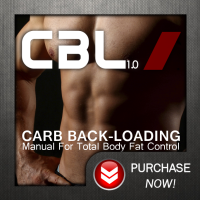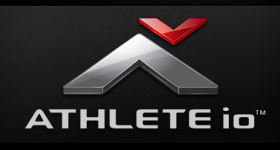This another follow-up, the last I intend to devote to carb back-loading until the dust settles. So let me begin at the beginning…
Carb back-loading came right out of a black-ops nutrition plan that…wait a minute. That’s not right. This plan came about because some physicist who happened to lift weights was tired of being pudgy and happened to have one of the finest medical libraries in the world only a mile away from his house, and even after moving, continued reading the journals and applying the knowledge in the trenches—which, yes, is an important part of any scientific work. (I don’t know, that sounds like an okay creation story, but the black-ops thing is definitely more sexy. Oh well, the truth is what it is.)
With all that research, there should be a paper trail and there is, for which someone on Elite rightly asked to see. He was rude about it and some might argue imbecilic, but his point is valid. I should put my money where my mouth is.
The Goal
 I actually understand this stuff…and love it!
I actually understand this stuff…and love it!Carb back-loading aims to allow a serious athlete, either recreational or professional, to maintain or increase strength and maintain or—depending how much excess fat they carry—increase muscle mass while losing body fat. Part of the goal, as it always should be, is time efficiency. There’s no reason to come up with a plan that takes so much time, life devolves into a constant cycle of eating, training, working and sleeping where, spare time is used for emergency bathroom breaks. By time efficient, I don’t mean easy, I only mean that we should get maximum results from the invested time.
The Guiding Research
It is well known that low insulin levels, which occur in the absence of dietary carbohydrates, can accelerate the release of fatty acids, and increase fat burning (called lipolysis in the literature)1,2. This is true even during exercise3-19. Once carbs enter the diet during the day, even if for a single meal, fat burning is hampered for the entire rest of the day20.
There is also no disputing that insulin sensitivity is highest in the morning and early afternoon, and by evening, has hit its lowest point21-24. Studies also show that eating more food in the beginning of the day when sensitivity is high causes more muscle than fat to be lost during dieting, but that eating most of your calories in the evening causes the loss of body fat and the preservation of muscle25-28.
Considering only the above information, if one wants to burn fat, they would refrain from eating carbohydrates for as long as possible during the day and, if possible, not at all.
But there’s muscle to be built and if not built, then spared. Insulin is the ideal hormone to target to spare muscle mass, levels of which we can manipulate with carbs. Well, there’s a problem: we’re avoiding carbs. The alternative is hyperaminoacidemia, or keeping blood levels of amino acids high, particularly leucine29-31. Although I didn’t mention it as an integral part of carb back-loading, it is, just as it is essential for any diet, hypertrophy or strength program. Protein 2.0 has more details.
 Yes, I do my homework.
Yes, I do my homework.Post-workout is also an important consideration for growth. The maximum amount of growth possible comes with consuming high amounts of fast-absorbing proteins and fast-absorbing carbs immediately post-workout32-38. Recent findings also show that muscle growth requires not just lots of calories, but lots of carbs39, 40. Ensuring that liver or muscle tissue absorbs most of these carbs would be a boon, as glycogen stores could be rapidly replenished. If the carbs replenish glycogen stores, there won’t be an excess that end up in fat cells where enzymes, most importantly fatty-acid synthase, will convert the carbon backbones of glucose into fatty acids, then to triglycerides for storage41-43.
Damn we’ve got some lofty goals and some nasty problems. Building muscle requires eating a lot of carbs, but eating a lot of carbs can increase body fat. I won’t even get into the nervous system inefficiencies that can be caused by attempting to regulate blood sugar manually, rather than letting the body reach homeostasis.
If we can avoid carbs during the most insulin-sensitive parts of the day, we can avoid fat accumulation, but we also lose insulin sensitivity in muscle tissue. And yes, I know, resistance training increases skeletal muscle insulin sensitivity44, 45, but it still fluctuates through the day. We would like muscles to be at their peak of glucose absorption when fat cells are at their nadir.
Luckily, the mechanism by which muscle cells absorb glucose is not only triggered by insulin. I’ve talked about them in past posts, those little chunks of protein that shuttle glucose through the cellular membrane. They are called GLUcose Transporters or GLUTs (glootz) for short. This fact is so basic, it nary warrants a citation, but I know someone will call me a liar before they check Wikipedia, so here46, 47.
The predominant GLUTs in muscle cells—GLUT-4, the same type as in fat cells—normally need insulin-stimulation to come to the surface of the cell where the transporters can start ferrying glucose into the nucleus for metabolism. This is called insulin-mediated translocation. Non-insulin-mediated translocation is when GLUT-4s come to the surface to do their thing without signaling from insulin. In a nut shell: GLUT-4s need to be present at the skeletal muscle cell surface for the cell to use glucose and there are two ways this is accomplished. One requires insulin.
 No carbs before lifting? I can handle that.
No carbs before lifting? I can handle that.The other, the one we can use to our advantage, requires resistance training. Contracting muscles under load causes GLUT-4 translocation in muscle tissue, independent of insulin action (an excellent review of the scientific literature is here48). So weight lifting has the same effect on GLUT-4s as insulin, which means we can make the muscles transport as much glucose during non-peak insulin-sensitivity hours (the evening) as during the morning. This is getting technical, but really, it means lifting makes your muscles absorb sugar whether there’s insulin or not, and whether your muscles are sensitive to it or not.
Now we have the final piece in place. We target muscle tissue to soak up sugar at an accelerated rate while fat cells struggle to do the same. Putting all the pieces together, we get optimal times to eat different nutrients (the basic concept of nutrient timing, which is at least 150 years old, and arguably 2 to 3000 years old), and an optimal time to resistance train—note “resistance train” and not just “workout”, like say cardio.
Putting It Together
The time of your workout is no longer a variable for optimum fat loss while potentiating the possibility of hypertrophy and strength: you must lift at the end of the early afternoon, completing your workout to coincide with the beginning of the lowest point of insulin sensitivity. For the average person living the 9-5 life, the workout should start somewhere from 3 to 5. Later is better than earlier. Let me emphasize again, start. Your workout should start between 3 to 5, and up to 6 is still near optimal—a workout from 5:30pm to 7pm is great and gives you plenty of time to load up on some carbs.
Now that workout time is no longer an option, I can safely say, “do not eat any carbs until workout time.” You can consume them during the workout if it will be abnormally intense, or you feel depleted from the day before (you didn’t get your glycogen reserves filled). Research teaches us that the body will not accumulate fat during the workout (no lipogenesis) even while consuming carbs.
After the workout, if not during, start loading carbs. The muscle tissue now has a high affinity for glucose, gobbling it up like a sponge, while fat cells can’t absorb much. And although lipogenesis is always hampered by weight lifting, the effect is short lived at about an hour or two50, 51 and we need to continue stuffing carbs down the pipe for the last several hours before sleep to replenish glycogen stores.
Non-Optimal Workout Times
You can back-load carbs, even if you lift in the morning, but it is sub-optimal. I explain how in the previous post. You may not be able to schedule your workouts for optimal gains, but we make do with what we have, we adapt and succeed, even if success comes in a slightly longer amount of time. If you want to whine, then there’s always Precision Nutrition, which is a good system, and there will be fruits and tossed salads for all.
- Borer KT. Hormonal regulation of fuel use in exercise. In: Exercise endocrinology. Champaign, IL: Human Kinetics, 2003:97–120.
- Volek JS, Sharman RJ, Love DM, et al. Body composition and hormonal responses to a carbohydrate-restricted diet. Metabolism 2002;51:864–70.
- Rauch HG, Hawley JA, Woodey M, Noakes TD, Dennis SC. Effects of ingesting a sports bar versus glucose polymer on substrate utilisation and ultra-endurance performance. Int J Sports Med. 1999 May;20(4):252-7.
- Maughan RJ, Williams C, Campbell DM, Hepburn D. Fat and carbohydrate metabolism during low intensity exercise: effects of the availability of muscle glycogen. Eur J Appl Physiol Occup Physiol. 1978 Jul 17;39(1):7-16.
- Vogt M, Puntschart A, Howald H, Mueller B, Mannhart C, Gfeller-Tuescher L, Mullis P, Hoppeler H. Effects of dietary fat on muscle substrates, metabolism, and performance in athletes. Med Sci Sports Exerc. 2003 Jun;35(6):952-60.
- Jacobs KA, Paul DR, Geor RJ, Hinchcliff KW, Sherman WM. Dietary composition influences short-term endurance training-induced adaptations of substrate partitioning during exercise. Int J Sport Nutr Exerc Metab. 2004 Feb;14(1):38-61.
- Carey AL, Staudacher HM, Cummings NK, Stepto NK, Nikolopoulos V, Burke LM, Hawley JA. Effects of fat adaptation and carbohydrate restoration on prolonged endurance exercise. J Appl Physiol. 2001 Jul;91(1):115-22.
- Phinney SD, Bistrian BR, Evans WJ, Gervino E, Blackburn GL. The human metabolic response to chronic ketosis without caloric restriction: preservation of submaximal exercise capability with reduced carbohydrate oxidation. Metabolism. 1983 Aug;32(8):769-76.
- Van Zyl CG, Lambert EV, Hawley JA, Noakes TD, Dennis SC. Effects of medium-chain triglyceride ingestion on fuel metabolism and cycling performance. J Appl Physiol. 1996 Jun;80(6):2217-25.
- Zderic TW, Davidson CJ, Schenk S, Byerley LO, Coyle EF. High-fat diet elevates resting intramuscular triglyceride concentration and whole body lipolysis during exercise. Am J Physiol Endocrinol Metab. 2004 Feb;286(2):E217-25. Epub 2003 Oct 14.
- Schrauwen P, Wagenmakers AJ, van Marken Lichtenbelt WD, Saris WH, Westerterp KR. Increase in fat oxidation on a high-fat diet is accompanied by an increase in triglyceride-derived fatty acid oxidation. Diabetes. 2000 Apr;49(4):640-6.
- Helge JW, Watt PW, Richter EA, Rennie MJ, Kiens B. Fat utilization during exercise: adaptation to a fat-rich diet increases utilization of plasma fatty acids and very low density lipoprotein-triacylglycerol in humans. J Physiol. 2001 Dec 15;537(Pt 3):1009-20.
- Pagan JD, Geor RJ, Harris PA, Hoekstra K, Gardner S, Hudson C, Prince A. Effects of fat adaptation on glucose kinetics and substrate oxidation during low-intensity exercise. Equine Vet J Suppl. 2002 Sep(34):33-8.
- Rowlands DS, Hopkins WG. Effects of high-fat and high-carbohydrate diets on metabolism and performance in cycling. Metabolism. 2002 Jun;51(6):678-90.
- Mollica MP, Iossa S, Liverini G, Soboll S. Stimulation of oxygen consumption following addition of lipid substrates in liver and skeletal muscle from rats fed a high-fat diet. Metabolism. 1999 Oct;48(10):1230-5.
- Goedecke JH, Christie C, Wilson G, Dennis SC, Noakes TD, Hopkins WG, Lambert EV. Metabolic adaptations to a high-fat diet in endurance cyclists. Metabolism. 1999 Dec;48(12):1509-17.
- Okano G, Sato Y, Murata Y. Effect of elevated blood FFA levels on endurance performance after a single fat meal ingestion. Med Sci Sports Exerc. 1998 May;30(5):763-8.
- Muoio DM, Leddy JJ, Horvath PJ, Awad AB, Pendergast DR. Effect of dietary fat on metabolic adjustments to maximal VO2 and endurance in runners. Med Sci Sports Exerc. 1994 Jan;26(1):81-8.
- Stepto NK, Carey AL, Staudacher HM, Cummings NK, Burke LM, Hawley JA. Effect of short-term fat adaptation on high-intensity training. Med Sci Sports Exerc. 2002 Mar;34(3):449-55.
- Martin A, Normand S, Sothier M, Peyrat J, Louche-Pelissier C, Laville M. Is advice for breakfast consumption justified? Results from a short-term dietary and metabolic experiment in young healthy men. Br J Nutr. 2000 Sep;84(3):337-44.
- Gautier JF, Cathelineau G. Insulin sensitivity and hepatic glucose production: nycthemeral variations. Diabetes Metab. 1997 Nov;23 Suppl 4:35-8.
- Benedict C, Kern W, Schmid SM, Schultes B, Born J, Hallschmid M. Psychoneuroendocrinology. Early morning rise in hypothalamic-pituitary-adrenal activity: a role for maintaining the brain’s energy balance. 2009 Apr;34(3):455-62.
- Waldhäusl W. Circadian rhythms of insulin needs and actions. Diabetes Res Clin Pract. 1989 May 15;6(4):S17-24.
- Pardini L, Kaeffer B. Feeding and circadian clocks. Reprod Nutr Dev. 2006 Sep-Oct;46(5):463-80.
- Sensi S, Capani F. Chronobiological aspects of weight loss in obesity: effects of different meal timing regimens. Chronobiol Int. 1987;4(2):251-61.
- Simeon DT, Grantham-McGregor S. Effects of missing breakfast on the cognitive functions of school children of differing nutritional status. Am J Clin Nutr. 1989 Apr;49(4):646-53.
- Benton D, Parker PY. Breakfast, blood glucose, and cognition. Am J Clin Nutr. 1998 Apr;67(4):772S-778S.
- Cueto S. Breakfast and performance. Public Health Nutr. 2001 Dec;4(6A):1429-31. Review.
- Norton LE, Layman DK. Leucine regulates translation initiation of protein synthesis in skeletal muscle after exercise. J Nutr 2006;136:533S–537S.
- Blomstrand E, Eliasson J, Karlsson HK, et al. Branched-chain amino acids activate key enzymes in protein synthesis after physical exercise. J Nutr 2006;136:269S–73S.
- Garlick PJ. The role of leucine in the regulation of protein metabolism. J Nutr 2005;135:1553S–6S.
- Tipton KD, Ferrando AA, Phillips SM, et al. Postexercise net protein synthesis in human muscle from orally administered amino acids. Am J Physiol 1999;276:E628–34.
- Rasmussen BB, Tipton KD, Miller SL, et al. An oral essential amino acidcarbohydrate supplement enhances muscle protein anabolism after resistance exercise. J Appl Physiol 2000;88:386–92.
- Wolfe RR. Protein supplements and exercise. Am J Clin Nutr 2000;72:551S–7S.
- Lemon PW, Berardi JM, Noreen EE. The role of protein and amino acid supplements in the athlete’s diet: does type or timing of ingestion matter? Curr Sports Med Rep 2002;1:214–21.
- Ivy J, Portman R. Nutrient timing: the future of sports nutrition. North Bergen, NJ: Basic Health Publications, 2004.
- Levenhagen DK, Gresham JD, Carlson MG, et al. Postexercise nutrient intake timing in humans is critical to recovery of leg glucose and protein homeostasis. Am J Physiol Endocrinol Metab 2001;280:E982–93.
- Fielding RA, Parkington J. What are the dietary protein requirements of physically active individuals? New evidence on the effects of exercise on protein utilization during post-exercise recovery. Nutr Clin Care 2002;5:191–6.
- Fujita S, Dreyer HC, Drummond MJ, Glynn EL, Cadenas JG, Yoshizawa F, Volpi E, Rasmussen BB. Nutrient signalling in the regulation of human muscle protein synthesis. J Physiol. 2007 Jul 15;582(Pt 2):813-23.
- Pasiakos SM, Vislocky LM, Carbone JW, Altieri N, Konopelski K, Freake HC, Anderson JM, Ferrando AA, Wolfe RR, Rodriguez NR. Acute energy deprivation affects skeletal muscle protein synthesis and associated intracellular signaling proteins in physically active adults. J Nutr. 2010 Apr;140(4):745-51.
- Chascione C, Elwyn DH, Davila M, Gil KM, Askanazi J, Kinney JM. Effect of carbohydrate intake on de novo lipogenesis in human adipose tissue. Am J Physiol. 1987 Dec;253(6 Pt 1):E664-9.
- Boll M, Weber LW, Stampfl A. Nutritional regulation of the activities of lipogenic enzymes of rat liver and brown adipose tissue. Z Naturforsch [C]. 1996 Nov-Dec;51(11-12):859-69.
- Schwarz JM, Neese RA, Turner S, Dare D, Hellerstein MK. Short-term alterations in carbohydrate energy intake in humans. Striking effects on hepatic glucose production, de novo lipogenesis, lipolysis, and whole-body fuel selection. J Clin Invest. 1995 Dec;96(6):2735-43.
- Miller WJ, Sherman WM, Ivy JL. Effect of strength training on glucose tolerance and post-glucose insulin response. Med Sci Sports Exerc. 1984 Dec;16(6):539-43.
- Craig BW, Everhart J, Brown R. The influence of high-resistance training on glucose tolerance in young and elderly subjects. Mech Ageing Dev. 1989 Aug;49(2):147-57. Review.
- Barnard RJ, Youngren JF. Regulation of glucose transport in skeletal muscle. FASEB J. 1992 Nov;6(14):3238-44. Review.
- Lauritzen HP, Schertzer JD. Measuring GLUT4 translocation in mature muscle fibers. Am J Physiol Endocrinol Metab. 2010 May 25. [Epub ahead of print]
- Hayashi T, Wojtaszewski JF, Goodyear LJ. Exercise regulation of glucose transport in skeletal muscle. Am J Physiol. 1997 Dec;273(6 Pt 1):E1039-51.
- Bird SP, Tarenning KM, Marino FE. Independent and combined effects of liquid carbohydrate/essential amino acid ingestion on hormonal and muscular adaptations following resistance training in untrained men. Eur J Appl Physiol 2006;97:225–38.
- Krzentowski G, Pirnay F, Luyckx AS, et al. Metabolic adaptations in postexercise recovery. Clin Physiol 1982;2:277–88.
- Folch N, Peronnet F, Massicotte D, et al. Metabolic response to small and large 13C-labelled pasta meals following rest or exercise in man. Br J Nutr 2001;85:671–80.








Recent Comments